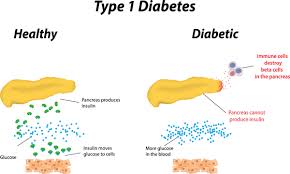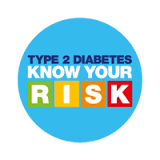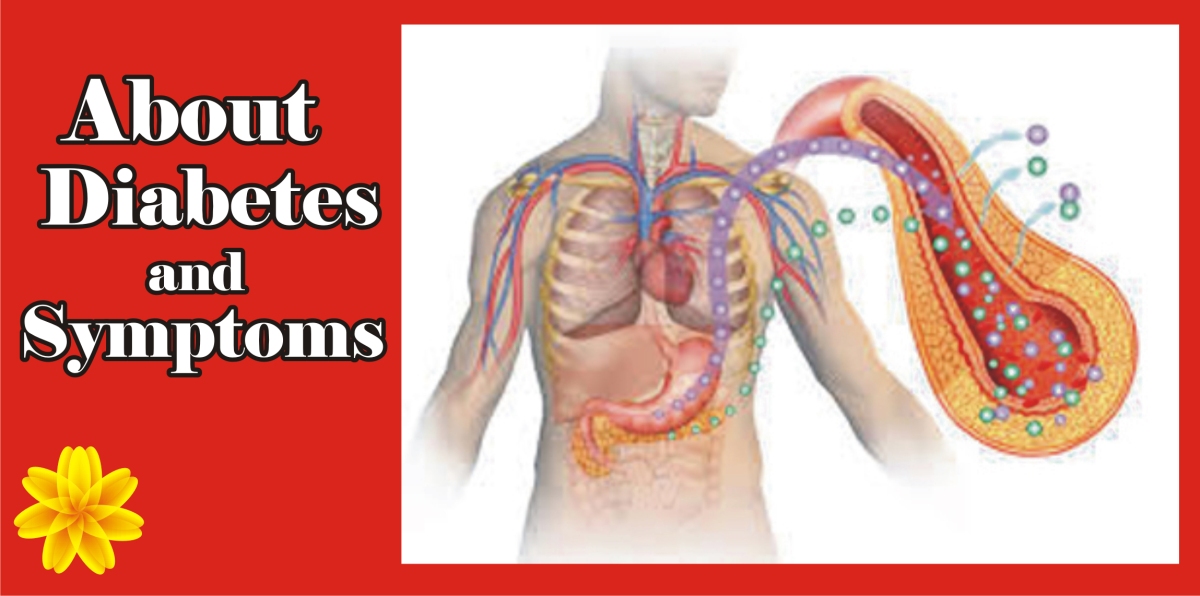Diabetes, often referred to by doctors as diabetes mellitus, describes a group of metabolic diseases in which the person has high blood glucose (blood sugar), either because insulin production is inadequate, or because the body’s cells do not respond properly to insulin, or both. Patients with high blood sugar will typically experience polyuria (frequent urination), they will become increasingly thirsty (polydipsia) and hungry (polyphagia).
Fast facts on diabetes
Here are some key points about diabetes. More detail and supporting information is in the main article.
- Diabetes is a long-term condition that causes high blood sugar levels.
- In 2013 it was estimated that over 382 million people throughout the world had diabetes (Williams textbook of endocrinology).
- Type 1 Diabetes – the body does not produce insulin. Approximately 10% of all diabetes cases are type 1.
- Type 2 Diabetes – the body does not produce enough insulin for proper function. Approximately 90% of all cases of diabetes worldwide are of this type.
- Gestational Diabetes – this type affects females during pregnancy.
- The most common diabetes symptoms include frequent urination, intense thirst and hunger, weight gain, unusual weight loss, fatigue, cuts and bruises that do not heal, male sexual dysfunction, numbness and tingling in hands and feet.
- If you have Type 1 and follow a healthy eating plan, do adequate exercise, and take insulin, you can lead a normal life.
- Type 2 patients need to eat healthily, be physically active, and test their blood glucose. They may also need to take oral medication, and/or insulin to control blood glucose levels.
- As the risk of cardiovascular disease is much higher for a diabetic, it is crucial that blood pressure and cholesterol levels are monitored regularly.
- As smoking might have a serious effect on cardiovascular health, diabetics should stop smoking.
- Hypoglycemia – low blood glucose – can have a bad effect on the patient. Hyperglycemia – when blood glucose is too high – can also have a bad effect on the patient.
There are three types of diabetes:
1) Type 1 diabetes
The body does not produce insulin. Some people may refer to this type as insulin- dependent diabetes, juvenile diabetes, orearly-onset diabetes. People usually develop type 1 diabetes before their 40th year, often in early adulthood or teenage years.
dependent diabetes, juvenile diabetes, orearly-onset diabetes. People usually develop type 1 diabetes before their 40th year, often in early adulthood or teenage years.
Type 1 diabetes is nowhere near as common as type 2 diabetes. Approximately 10% of all diabetes cases are type 1.
Patients with type 1 diabetes will need to take insulin injections for the rest of their life. They must also ensure proper blood-glucose levels by carrying out regular blood tests and following a special diet.
2) Type 2 diabetes
The body does not produce enough insulin for proper function, or the cells in the body do not react to insulin (insulin resistance).
Approximately 90% of all cases of diabetes worldwide are type 2.

Some people may be able to control their type 2 diabetes symptoms by losing weight, following a healthy diet, doing plenty of exercise, and monitoring their blood glucose levels. However, type 2 diabetes is typically a progressive disease – it gradually gets worse – and the patient will probably end up have to take insulin, usually in tablet form.
Overweight and obese people have a much higher risk of developing type 2 diabetes compared to those with a healthy body weight. People with a lot of visceral fat, also known as central obesity, belly fat, or abdominal obesity, are especially at risk. Being overweight/obese causes the body to release chemicals that can destabilize the body’s cardiovascular and metabolic systems.
Being overweight, physically inactive and eating the wrong foods all contribute to our risk of developing type 2 diabetes. Drinking just one can of (non-diet) soda per day can raise our risk of developing type 2 diabetes by 22%, researchers from Imperial College London reported in the journal Diabetologia. The scientists believe that the impact of sugary soft drinks on diabetes risk may be a direct one, rather than simply an influence on body weight.
The risk of developing type 2 diabetes is also greater as we get older. Experts are not completely sure why, but say that as we age we tend to put on weight and become less physically active. Those with a close relative who had/had type 2 diabetes, people of Middle Eastern, African, or South Asian descent also have a higher risk of developing the disease.
Men whose testosterone levels are low have been found to have a higher risk of developing type 2 diabetes.
3) Gestational diabetes
This type affects females during pregnancy. Some women have very high levels of glucose in their blood, and their bodies are unable to produce enough insulin to transport all of the glucose into their cells, resulting in progressively rising levels of glucose.
Diagnosis of gestational diabetes is made during pregnancy.
The majority of gestational diabetes patients can control their diabetes with exercise and diet. Between 10% to 20% of them will need to take some kind of blood-glucose-controlling medications. Undiagnosed or uncontrolled gestational diabetes can raise the risk of complications during childbirth. The baby may be bigger than he/she should be.
Scientists from the National Institutes of Health and Harvard University found that women whose diets before becoming pregnant were high in animal fat and cholesterol had a higher risk for gestational diabetes, compared to their counterparts whose diets were low in cholesterol and animal fats.
Diabetes symptoms

What is prediabetes?
The vast majority of patients with type 2 diabetes initially had prediabetes. Their blood glucose levels where higher than normal, but not high enough to merit a diabetes diagnosis. The cells in the body are becoming resistant to insulin.
Studies have indicated that even at the prediabetes stage, some damage to the circulatory system and the heart may already have occurred.
Diabetes is a metabolism disorder
Diabetes (diabetes mellitus) is classed as a metabolism disorder. Metabolism refers to the way our bodies use digested food for energy and growth. Most of what we eat is broken down into glucose. Glucose is a form of sugar in the blood – it is the principal source of fuel for our bodies.
When our food is digested, the glucose makes its way into our bloodstream. Our cells use the glucose for energy and growth. However, glucose cannot enter our cells without insulin being present – insulin makes it possible for our cells to take in the glucose.
Insulin is a hormone that is produced by the pancreas. After eating, the pancreas automatically releases an adequate quantity of insulin to move the glucose present in our blood into the cells, as soon as glucose enters the cells blood-glucose levels drop.
A person with diabetes has a condition in which the quantity of glucose in the blood is too elevated (hyperglycemia). This is because the body either does not produce enough insulin, produces no insulin, or has cells that do not respond properly to the insulin the pancreas produces. This results in too much glucose building up in the blood. This excess blood glucose eventually passes out of the body in urine. So, even though the blood has plenty of glucose, the cells are not getting it for their essential energy and growth requirements.
How to determine whether you have diabetes, prediabetes or neither
Doctors can determine whether a patient has a normal metabolism, prediabetes or diabetes in one of three different ways – there are three possible tests:
- The A1C test
– at least 6.5% means diabetes
– between 5.7% and 5.99% means prediabetes
– less than 5.7% means normal - The FPG (fasting plasma glucose) test
– at least 126 mg/dl means diabetes
– between 100 mg/dl and 125.99 mg/dl means prediabetes
– less than 100 mg/dl means normal
An abnormal reading following the FPG means the patient has impaired fasting glucose (IFG) - The OGTT (oral glucose tolerance test)
– at least 200 mg/dl means diabetes
– between 140 and 199.9 mg/dl means prediabetes
– less than 140 mg/dl means normal
An abnormal reading following the OGTT means the patient has impaired glucose tolerance (IGT)
Complications linked to badly controlled diabetes:
Below is a list of possible complications that can be caused by badly controlled diabetes:
- Eye complications – glaucoma, cataracts, diabetic retinopathy, and some others.
- Foot complications – neuropathy, ulcers, and sometimes gangrene which may require that the foot be amputated
- Skin complications – people with diabetes are more susceptible to skin infections and skin disorders
- Heart problems – such as ischemic heart disease, when the blood supply to the heart muscle is diminished
- Hypertension – common in people with diabetes, which can raise the risk of kidney disease, eye problems, heart attack and stroke
- Mental health – uncontrolled diabetes raises the risk of suffering from depression, anxiety and some other mental disorders
- Hearing loss – diabetes patients have a higher risk of developing hearing problems
- Gum disease – there is a much higher prevalence of gum disease among diabetes patients
- Gastroparesis – the muscles of the stomach stop working properly
- Ketoacidosis – a combination of ketosis and acidosis; accumulation of ketone bodies and acidity in the blood.
- Neuropathy – diabetic neuropathy is a type of nerve damage which can lead to several different problems.
- HHNS (Hyperosmolar Hyperglycemic Nonketotic Syndrome) – blood glucose levels shoot up too high, and there are no ketones present in the blood or urine. It is an emergency condition.
- Nephropathy – uncontrolled blood pressure can lead to kidney disease
- PAD (peripheral arterial disease) – symptoms may include pain in the leg, tingling and sometimes problems walking properly
- Stroke – if blood pressure, cholesterol levels, and blood glucose levels are not controlled, the risk of stroke increases significantly
- Erectile dysfunction – male impotence.
- Infections – people with badly controlled diabetes are much more susceptible to infections
- Healing of wounds – cuts and lesions take much longer to heal
Common symptoms of diabetes
The most common signs and symptoms of diabetes are:
Frequent urination
Have you been going to the bathroom to urinate more often recently? Do you notice that you spend most of the day going to the toilet? When there is too much glucose (sugar) in your blood you will urinate more often.
If your insulin is ineffective, or not there at all, your kidneys cannot filter the glucose back into the blood. The kidneys will take water from your blood in order to dilute the glucose – which in turn fills up your bladder.
Disproportionate thirst
If you are urinating more than usual, you will need to replace that lost liquid. You will be drinking more than usual. Have you been drinking more than usual lately?
Intense hunger
As the insulin in your blood is not working properly, or is not there at all, and your cells are not getting their energy, your body may react by trying to find more energy – food. You will become hungry.
Weight gain
This might be the result of the above symptom (intense hunger).
Unusual weight loss
This is more common among people with Diabetes Type 1. As your body is not making insulin it will seek out another energy source (the cells aren’t getting glucose). Muscle tissue and fat will be broken down for energy. As Type 1 is of a more sudden onset and Type 2 is much more gradual, weight loss is more noticeable with Type 1.
Increased fatigue
If your insulin is not working properly, or is not there at all, glucose will not be entering your cells and providing them with energy. This will make you feel tired and listless.
Irritability
Irritability can be due to your lack of energy.
Blurred vision
This can be caused by tissue being pulled from your eye lenses. This affects your eyes’ ability to focus. With proper treatment this can be treated. There are severe cases where blindness or prolonged vision problems can occur.
Cuts and bruises don’t heal properly or quickly
Do you find cuts and bruises take a much longer time than usual to heal? When there is more sugar (glucose) in your body, its ability to heal can be undermined.
More skin and/or yeast infections
When there is more sugar in your body, its ability to recover from infections is affected. Women with diabetes find it especially difficult to recover from bladder and vaginal infections.
Itchy skin
A feeling of itchiness on your skin is sometimes a symptom of diabetes.
Gums are red and/or swollen – Gums pull away from teeth
If your gums are tender, red and/or swollen this could be a sign of diabetes. Your teeth could become loose as the gums pull away from them.
Frequent gum disease/infection
As well as the previous gum symptoms, you may experience more frequent gum disease and/or gum infections.
Sexual dysfunction among men
If you are over 50 and experience frequent or constant sexual dysfunction (erectile dysfunction), it could be a symptom of diabetes.
Numbness or tingling, especially in your feet and hands
If there is too much sugar in your body your nerves could become damaged, as could the tiny blood vessels that feed those nerves. You may experience tingling and/or numbness in your hands and feet.
Diabetes diagnosis

Diabetes can often be detected by carrying out a urine test, which finds out whether excess glucose is present. This is normally backed up by a blood test, which measures blood glucose levels and can confirm if the cause of your symptoms is diabetes.
If you are worried that you may have some of the above symptoms, you are recommended to talk to your Doctor or a qualified health professional.




